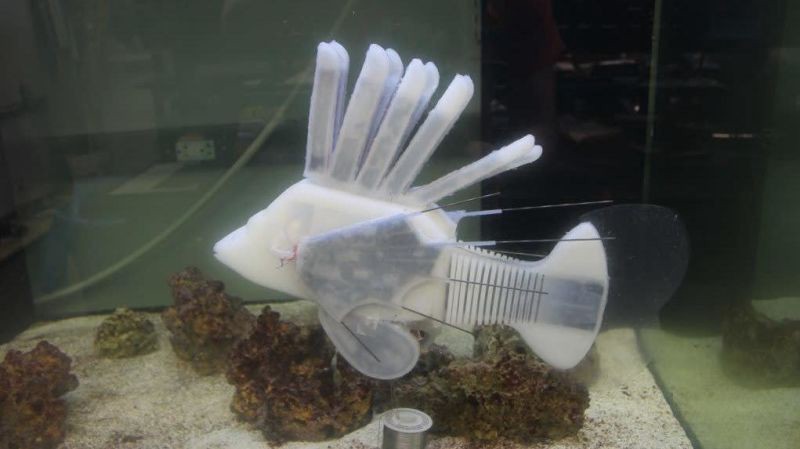‘Robotic Blood’ Powers and Propels Synthetic Lionfish

By Lauren Salig
Biology is full of highly complex systems that scientists have long studied in an attempt to mimic their mechanical and chemical functionality. Part of what makes human and animal bodies so efficient is the integrated multifunctionality of their parts: a leg is not just a mechanism for movement but also a place to store energy in the form of fat, and a home for long bones, which manufacture blood cells that transport energy elsewhere.
Robots tend to compartmentalize these tasks, separating functions like energy storage and motion. Having a different component for each function makes for bulkier devices that hinder robotic potential, especially in untethered robots that need to be lightweight but highly powered for use in long duration exploration or search and rescue missions.

James Pikul, assistant professor in the Department of Mechanical Engineering and Applied Mechanics, has co-authored a recent paper in Nature with colleagues from Cornell University demonstrating a robotic lionfish that combines energy storage and movement through the use of a hydraulic liquid the team refers to as “robotic blood.”
“Normal robots are made of parts that are highly optimized for specific tasks. This specializing results in compromises in the robot performance,” says Pikul. “For example, if we want a robot to operate longer, we have to add more batteries, but to do so we must remove actuators to maintain the same weight and size.”
To address this trade-off conundrum, the team modeled their robotic blood off of redox flow batteries in which some battery components store energy in liquid form until it is converted to electricity using a chemical reaction when needed. In the researchers’ robotic lionfish, the synthetic vascular system stored energy in the robotic blood in a similar fashion to redox flow batteries, while energy extracted from the robot blood powered a pump that pushed the same hydraulic liquid to propel the fin’s movement.

Using a soft, aquatic-based robot with their synthetic blood was a natural choice for the researchers because soft robots are commonly actuated with liquids. They figured if they could take the liquid already incorporated into the robot and imbue it with additional functionality, they could save space and weight by avoiding solid batteries.
Pikul is no stranger to designing optimized space to blur the distinction between structure and function. Just as this project sought to intelligently incorporate energy storage in a macro-scale robotic fish, Pikul has done the same on the nano-scale with his design of a material called metallic wood — a light but strong material with specially crafted spaces in its makeup that could be infused with energy storage components.
“We created the robotic fish as a way to show how adding multiple functionalities into robotic parts can dramatically increase their performance and capabilities,” Pikul says. “If the fluid was used to only actuate the robot and not store energy, the robot would only be able to travel an eighth of the distance.”
According to the researchers, their lionfish is the first robot to combine hydraulic force transmission, movement and energy storage into one system, resulting in a robotic fish that can swim for up to 36 hours. Their research reveals the untapped potential of multifunctional robotic design and could lead to soft robots with unprecedented ocean exploration abilities, although Pikul foresees even more far-reaching applications:
“I think the interesting future directions of this work are to integrate more complex and unique chemical functionality into fluids and use this to make robots with new and better capabilities that resemble animal capabilities,” says Pikul. “Also, I think there are nice applications of this work in other things besides soft robots, such as any machine that uses a fluid, from hard robots to electric vehicles and even airplanes.”
This work was supported by the US Office of Naval Research, grant number N00014–17–1–2837.
